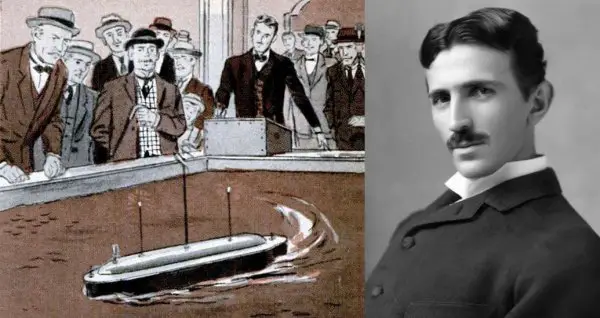In 1898 Nikola Tesla Presented Remotely Controlled Boat – People Thought It Was A Magic Trick
Tags: opinion

Nikola Tesla can be considered to be one of the greatest inventors in history, His innovations and genius have changed the entire world. His extraordinary contributions included developing induction motors, harnessing the alternating current (AC), and even his experiments with wireless power.
SUBSCRIBE TO THE TRUTH THEORY YOUTUBE CHANNEL, CLICK HERE
Nikola Tesla played with the ideas of wireless lighting and the distribution of electricity and understood the possibilities of wireless communication. He even performed X-Ray imaging.
Nikola Tesla possessed an eidetic memory (ability to vividly recall an image you are exposed to) with a vision for the future of mankind. His innovations and discoveries had majorly contributed to the development of several technologies that we enjoy in the present generation. He played a major role in the inventions of laser and radar technology, computers, remote control, robotics, and even smartphones.

Nikola Tesla Built The First Radio-Controlled Boat In 1898
Nikola Tesla made a public demonstration in 1898, which was very hard to imagine at that period of time. People thought it was a magic trick.
Tesla held this demonstration at the Electrical Exhibition in Madison Square Garden and people were excited to see this marvel, but the reality was way beyond their wildest expectations.
“The boat was equipped with a borrowed mind,” Tesla said.
READ: NIKOLA TESLA’S VIEWS ON FREE ENERGY AND ALIEN LIFE REVEALED IN THIS RARE INTERVIEW FROM 1931
The crowd saw the boat moving on its own and were completely surprised. They could not find a rational explanation for what was happening with the boat. Some called it magic, while others called it telepathy. Some even thought that there was a monkey inside that controlled the boat.
“When first shown… it created a sensation such as no other invention of mine has ever produced,” Tesla said.
The entire crowd was so mesmerized by what they had just seen that they did not know whether to laugh or run away from it.
When Nikola Tesla saw the reaction of the crowd, he tried to trick them into thinking that he could control the boat using only commands. He encouraged the crowd to ask questions to the boat.
Tesla used a small, radio-transmitting box by which he was able to control the tiny ship and even flash its lights on and off, without having any visible connection between the boat and the control box.
One asked, “What is the cube root of 64?”
In answer, the lights on the boat flashed 4 times.
Everyone gasped in admiration.
Tesla’s Remote Controlled Boat: Some Details Of This Gadget
This new invention of Tesla’s was covered in patent No. 613,809 (1898) and took the form of a radio-controlled boat which was comparatively heavier than the modern ones, a low-lying, steel craft about four feet long.
The exhibition in 1898 contained an indoor pool, a small ship that was 4 feet long, and a control box with several levers.
The ship’s deck was full of antennae for catching the signals. The tallest one was in the center and the other two, on the two sides, had small light bulbs.
The lights would assist the operator to look for the ship and its direction in the darkness. The ship’s movement was driven by a screw propeller with a keel and rudder, just like a nautical vessel.
There was an electric motor inside the boat’s hull, which drove the rudder and the propeller, a storage battery, and some mechanism that would receive the signals from the box.
Nikola Tesla’s invention would allow the operators to alter the ship’s speed and direction, without any wired connections and even control onboard gadgets, like the lights and other moving parts.
The method of control was not limited only to boats but also all sorts of vehicles and mechanisms. This invention in 1898 gave birth to robotics, which was way ahead of its time.
SUPPORT OUR WORK, CHECK OUT OUR PATREON PAGE
Newspaper headlines chose to focus on Tesla’s device to be used as a wirelessly controlled torpedo, even though his plans for the invention were not wholly aimed at warfare.
In a 1900 article from Century magazine, Tesla had a moment of self-realization, and saw his own mind and body as an automaton, reacting to external stimuli and situations.
He described that contemporary automatons were simply using a “borrowed mind,” which responded to orders from a distant and intelligent operator.
Nikola Tesla believed that one day humans will be able to create a machine with its “own mind,” that would act on environmental stimuli of its own accord.
Image credit: TCBA News
Leave Comment: